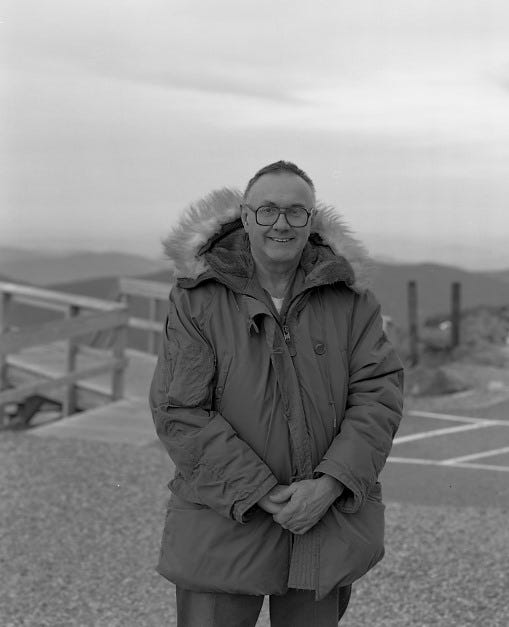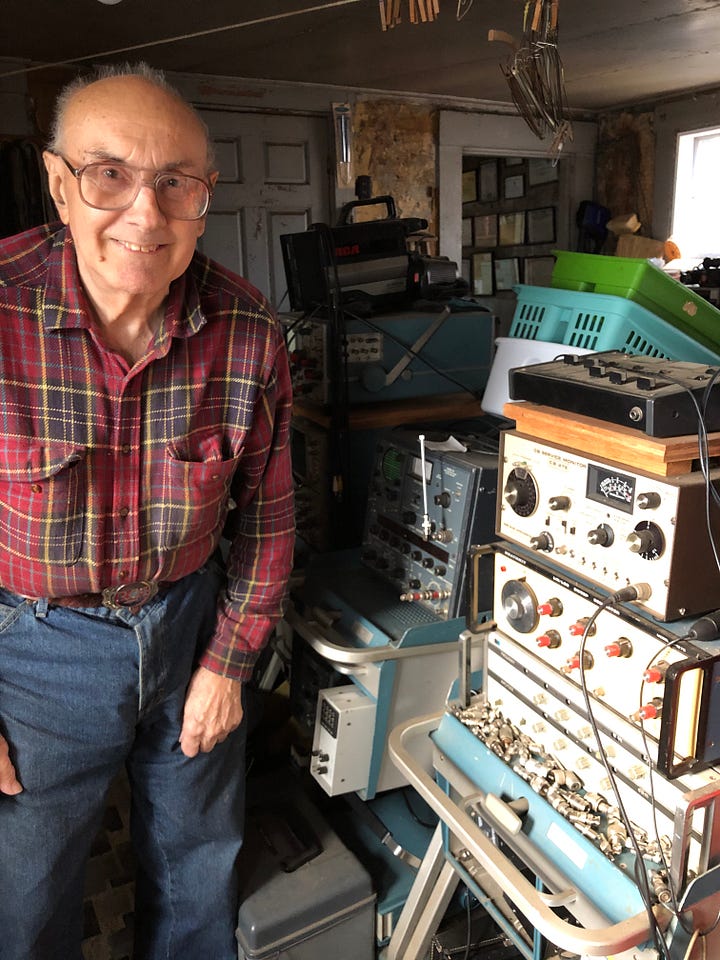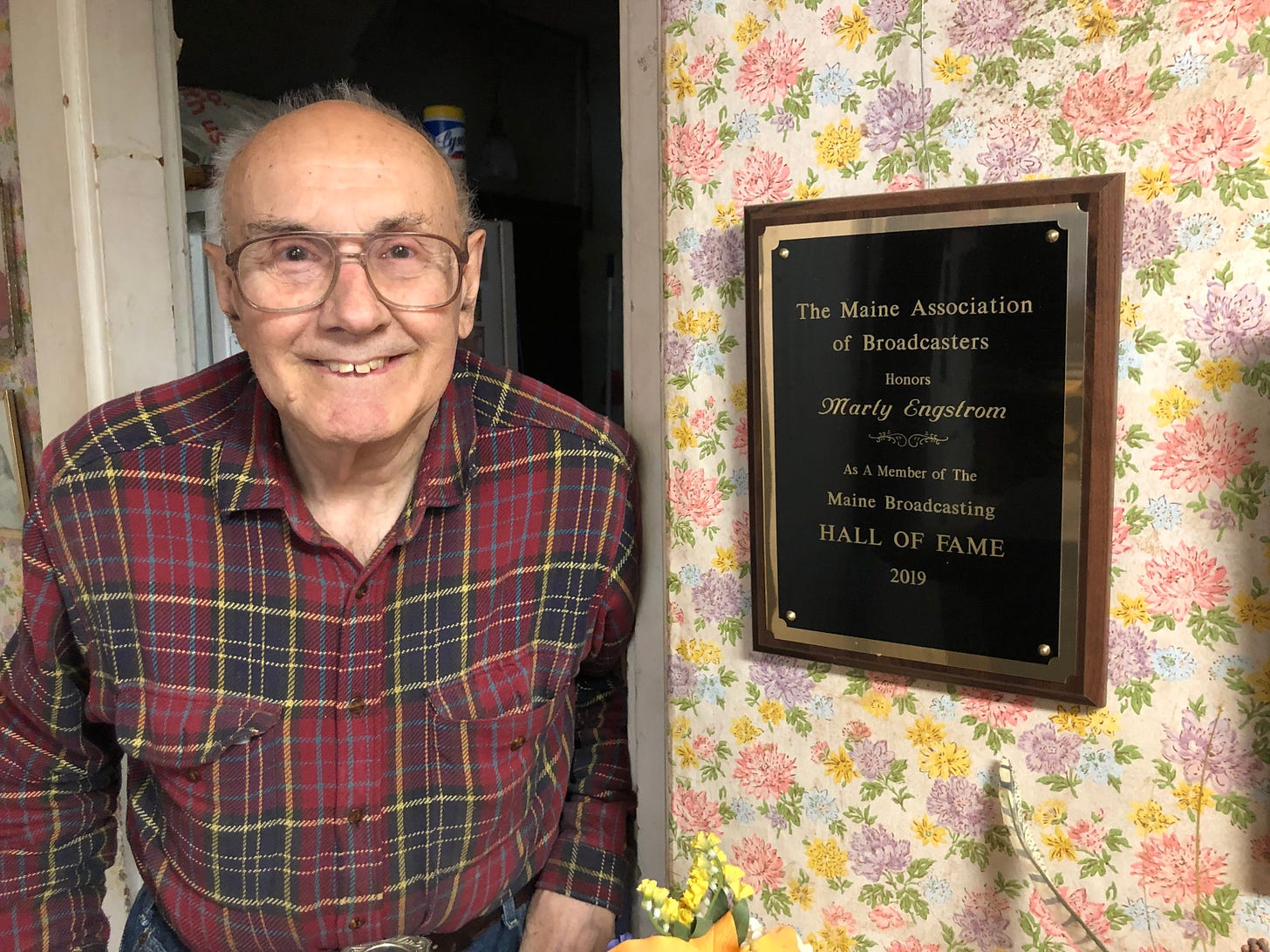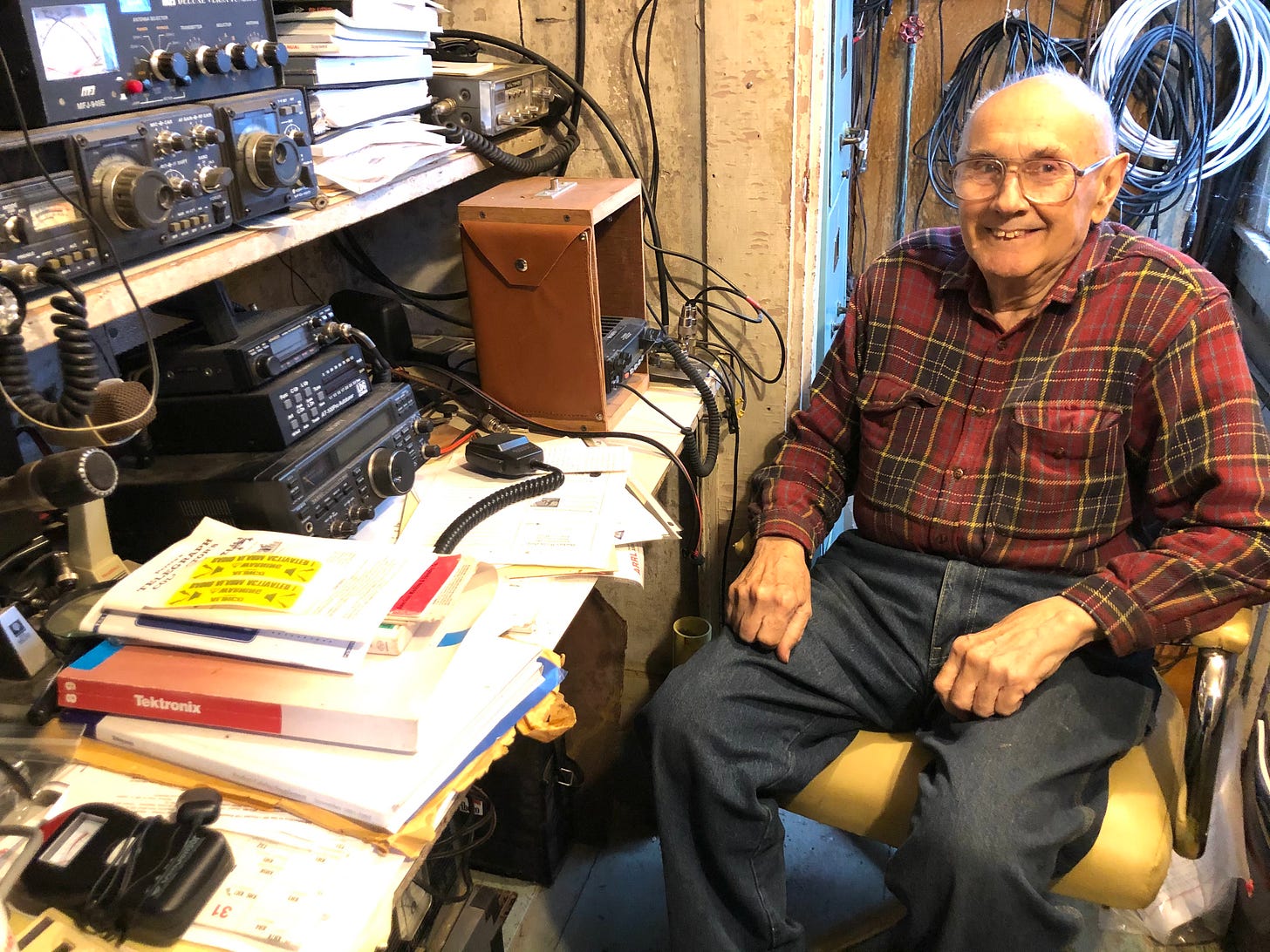Today, for the next couple days, we celebrate the curious life of a Mount Washington legend, Marty Engstrom, who passed away yesterday at the age of 86. What, you may ask was Marty famous for? Was it his climbing or skiing skills? Nope.
Marty was known across New England for primarily one thing, and it’s a hell of a legacy. You see, Marty was known for his smile.
A couple years ago, I had the very great honor of spending the day at Marty’s farm in Maine. We talked about his life as a weather broadcaster and how he became so beloved among lovers of the outdoors and Mount Washington. He was kind and funny and authentic - very much the gentleman and character that he played on TV. In other words, he was himself. I wrote a piece on my day with Marty for AMC Outdoors magazine and that piece became a chapter in my book, Stories From the White Mountain. To this day, it’s one of the proudest of my career.
But up until this moment, that story had only been released in those two places. So today, in honor of Marty on the Mountain, I’ll re-print that whole story below. It’s longer than my regular posts, so take your time with it. Then, come back tomorrow for Part 2 where I’ll post a little sidebar about Marty’s snowcat and show you a whole bunch of never before published photos of Marty, both historic and my own.
Rest easy Marty, thanks for the memories and the smile.


THIRTY SECONDS AND A SMILE: The Legend of Marty on the Mountain
Visiting the home of a legend is a curious thing.
Marty Engstrom, whose thirty second weather spots from the summit of Mount Washington became a comforting evening send off to millions of fans in Northern New England for nearly 40 years, is waiting for me at the porch door to his sprawling farmhouse in Fryeburg, Maine.
“Morning,” he says in his unique accent with the extended Os and dropped Rs. He smiles, and it’s THAT smile, the particular grin that endeared him to MWTW Channel 8 viewers for so many years. “Come on in.”
“I see you still keep up with the weather,” I say, pointing to the long snow measuring stick and precipitation can set up in his back yard, about 20 yards from the porch.
“Oh yeah, I use my binoculars here to watch the snow fall, then record it in a weather journal I’ve kept for a long time.”
“How long?” I ask.
“Well, since I retired.”
That would have been February of 2002 when Marty broadcast his last weather report from the top of New England. For 18 years since then, he’s kept a weather book in his workshop, journaling every day reports about the weather on this particular square of soil he’s called home since 1950.
A detailed weather log is a curious retirement hobby for a man who never studied for, nor intended on, being a weatherman.
“Totally an accident,” he says.
Never-the-less, the legend of Marty on the Mountain has grown over the years despite, or perhaps because of, Marty’s own protests. All he ever wanted to be was an engineer, a tinkerer, a man of transmitters and oscillators.
Instead, he became a Mount Washington celebrity and the most famous weatherman in New England.

After a stint in the Air Force, the engineer trained in radar mechanics arrived at the summit of Mount Washington in 1964 as part of the Poland Spring, Maine-based WMTW-TV 8 Mount Washington TV engineering crew.
His job, every other week, for eight days on and six days off would be to live in the place where the weather was the worst in the world and keep the TV station’s equipment running. What his job became, however, was quite different.
On his first day on the job, late in the afternoon, his boss matter-of-factly mentioned that Marty was to go on camera, live, and do the station’s daily weather show.
“Well, that came as a surprise,” Marty says in typical understated fashion. “So, I just went with the flow.”
That flow, along with Marty’s famous smile and endearing folksy charm propelled the Marty on the Mountain brand into celebrity status, a book about his adventures, speaking tours around the country, and just last fall, at the age of 83, a spot in the Maine Broadcasters Hall of Fame.
“I didn’t even know that organization existed until they gave me a call,” Marty says. “During my speech, I told them I had no intention of doing anything like this, that I was an engineer, not a TV talent.” Of course, as he says this to me, his eyes sparkle, giving away the entertainer behind the engineer.
Roger Griswold, the current WMTV chief meteorologist and Marty on the Mountain fan, laughs when asked about the secret to Marty’s success.
“Marty gave us all the ability to be there with him, before the internet and all that technology,” he says. “You can be the most accurate forecaster in the world, but your message has to convey your personality as well. He was genuine, just being himself. People loved that!”
But as authentic sounding and down to earth as Marty’s broadcasts were, they came from a place of hard work and preparation. He wrote his own scripts and spent time each day thinking about how to fill those 30 seconds.
“I did what I could to make it interesting because the weather itself would only take up maybe ten seconds,” he says. “So, I’d try to think up some sassy remark.”
Sometimes, Marty was joined on air by Pushka, the station’s cat mascot. Other times, there’d be technical problems. But none of that seemed to matter to Marty’s fans.
Gail Stevens Allard grew up in Alton, N.H. and the weather report was serious business in her house. She recalls her father making the family keep quiet until the moment Marty would give up his famous smile.
“As soon as he gave his grin, we knew we were released from the rule of silence and we’d start to giggle,” she says. “My father did his best imitation of that grin and it always sent us over the edge. Marty was a staple of my childhood and one of my favorite memories.”
Jill Harper Kyzer moved to Milford, N.H. from the Midwest with her family when she was seven and Marty’s weather reports are one of the first things she remembers about New England.
“His accent together with that flat delivery followed by the goofy grin seemed to never get old,” she says.
About that smile; Marty insists that his daily devilish grin at the end of those reports was an accident as well. “That was just nerves,” he says. “But it became my thing.”
That trademark smile has been well rewarded over the years. One wall of Marty’s living room is covered in awards and certificates. In a tiny backroom, another wall of ham radio certificates dominate a wall in the room where he broadcasts. He shows off his walls of books. Like a good, meticulous engineer, he’s labelled his stacks, like a librarian. Math. Architecture. Maine authors. UFOs.
As we tour the living museum that is his home, he tells me stories, non-stop rapid-fire yarns of his adventures; like the time the Mount Washington Sno-Cat nearly skidded over the side, only to be held to the road by a small rock, or how he narrowly escape a mid-air crash over Logan Airport while piloting his Cessna on a trip to Boston, or how he gave up hunting after an incident when a squirrel was in his gun sights, but stood up and put its little hand over his heart.
“I let it live,” Marty says, “and never shot another squirrel again.”
This was Marty’s great strength, of course, and secret weapon, an uncanny ability to conjure up the most fantastical stories.
“You just can ask him any question and let him go,” says Sarah Long, a WMTV meteorologist who worked as a summit observer at the Mount Washington Observatory in the late 1990s. “Either he has a super great memory or he’s really good at making it all up.”
Long recalls holiday dinners at the summit with Marty and the staff of the TV station where she’d just throw herself into a recliner with a cup of coffee and listen to Marty spin his yarns.
“His attention to detail and his memory is so sharp,” she says. “He’s an entertainer, he knows how to leave people with something to talk about.”
This is never truer than when Marty finally takes me into his workshop, a chilly room with a tall ceiling that’s attached to the barn. But this is no ordinary farmhouse workshop. Marty’s workshop is the sole domain of an engineer with 50 years of electronics craft under his belt, stacked from floor to ceiling with the most amazing collection of analog TV and radio equipment I’d ever laid eyes on. But there’s no mess. Everything is in its place, organized and cleaned. This is the true soul of Marty on the Mountain; not the weather, not the summit, but here where wires hang from the walls like spider webs and tool boxes overflow with every imaginable widget under the sun.
I’m speechless, but Marty jumps in.
“I’ll collect anything in the way of scientific equipment if it’s dirt cheap, and most of it is,” he says. “This shop is better equipped than most radio stations and a lot better equipped than we ever were at the top of the mountain.”
Marty Engstrom, the voice and smile so familiar to so many people for so many years, walks proudly through his shop, the heart of his farm and the very pulse which connects the long narrative of his life to New England and to Mount Washington.
I have one last question, though I think I know the answer. Do you miss the mountain?
“Nope, I’m mighty relieved to be shed of that,” he says without missing a beat. “I got off there alive and kicking and I don’t plan on going back.”
There’s a pause, and he says, “It was okay in the summer, though.” He smiles that smile and turns back to some random transmitter in the place he’s most comfortable and I’m certain that Marty on the Mountain’s legacy is secure.
Tomorrow: We’ll return with a photo album of Marty, past and present, and a short story about one of the most famous vehicles that got Marty to the top of the mountain. Thanks for sticking around. Please share this story with your White Mountain and hiking friends. And keep smiling!





